SpaceX will create a high-capacity satellite network with a delay of 25 ms

The other day, Ilona Mask company SpaceX announced that the practical implementation of its plans to create an Internet satellite network will begin in 2019. The company is going to deliver 4425 satellites to Earth’s orbit using its own Falcon 9 launch vehicle. The SpaceX management reported on their plans to the US Senate.
The difference between the new satellite network and the existing ones will be a low delay with a maximum of 25 ms. Typically, the delay is much higher ( according to the FCC - about 600 ms), but SpaceX plans to improve its “orbital infrastructure” in such a way as to avoid problems with communication and ensure maximum coverage of the Earth with maximum throughput.
So far, the year 2019 is regarded as a possible start date for the launch of satellites, but the company speaks about it much more confidently than last year . Then SpaceX representatives submitted an application to the Federal Communications Commission , specifying a detailed plan for the implementation of their project.
')
Already this year, most likely, in the second half, SpaceX will begin to independently test its satellites. By the end of the year, the first experimental apparatus will be launched, which will show in practice the possibility of achieving the set plans. The company plans to launch the last satellite in 2024, thus forming a whole constellation of its orbital spacecraft. Due to the fact that the company has its own launch vehicle, the cost of delivering satellites will be relatively low.

All 4425 satellites will be located at 83 different altitudes (from 1,110 km to 1,325 km). This is a low orbit. For comparison, the HughesNet satellite network devices are located at an altitude of 35,400 km. Thus, SpaceX satellites will receive and send a signal much faster than in the case of other networks whose satellites are located in high orbits.
Perhaps, after the formation of the main network, the company will work on creating an additional network, sending another 7,500 devices into orbit. This will significantly improve the already good quality of communication and the parameters of the network infrastructure.
The type of network in the case of SpaceX is a mesh network . According to the project team, this structure allows you to work quickly and efficiently, distributing resources in real time. Moreover, the company plans its actions in such a way as to avoid the interaction of its own network with any others. This will help not to interfere with other people's devices, ensuring the highest quality and fast work of their own.
User terminals SpaceX will make laptops equal in size. Users promise gigabit speeds. About the cost of connection, the monthly fee and other financial nuances is not reported yet.
Source: https://habr.com/ru/post/370439/
All Articles